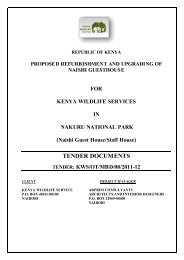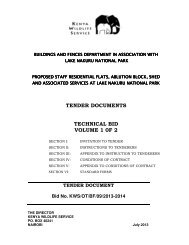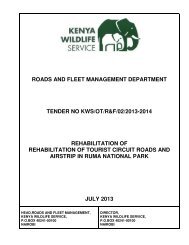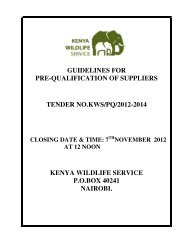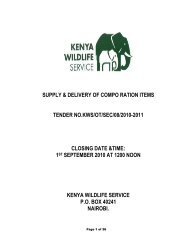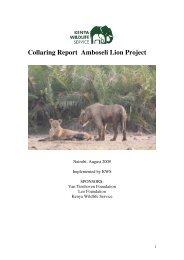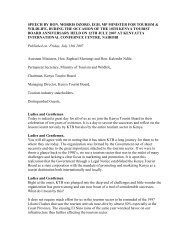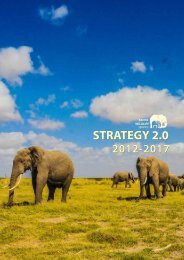Conservation and Management Strategy for the Elephant in Kenya
Conservation and Management Strategy for the Elephant in Kenya
Conservation and Management Strategy for the Elephant in Kenya
Create successful ePaper yourself
Turn your PDF publications into a flip-book with our unique Google optimized e-Paper software.
CONSERVATION AND MANAGEMENT STRATEGY FOR THE ELEPHANT IN KENYA 25<br />
Threat<br />
Cause<br />
Constra<strong>in</strong>t<br />
Preconditions /<br />
Assumption (enabl<strong>in</strong>g<br />
conditions / environment<br />
to reduce threats)<br />
Lack of awareness of value of elephants • Limited environmental education<br />
• Diplomatic immunity<br />
Inadequate law en<strong>for</strong>cement ef<strong>for</strong>t<br />
• Lack of en<strong>for</strong>cement capacity<br />
• Weak legislation <strong>and</strong> poor en<strong>for</strong>cement<br />
Poach<strong>in</strong>g /<br />
illegal kill<strong>in</strong>g<br />
• Limited capacity to mitigate conflicts<br />
Human-elephant conflict<br />
• Conflict<strong>in</strong>g l<strong>and</strong> use plann<strong>in</strong>g / practices<br />
Proliferation of illegal firearms • Instability <strong>in</strong> neighbour<strong>in</strong>g countries<br />
Increased dem<strong>and</strong> <strong>for</strong> wildlife meat • Lack of alternative livelihoods/poverty<br />
• Political stability<br />
<strong>in</strong> <strong>the</strong> region.<br />
• CITES will not<br />
reopen ivory trade<br />
• Political will<br />
Cultural practices – some cultures allow<br />
kill<strong>in</strong>g of an animal e.g. kill<strong>in</strong>g of a lion<br />
by <strong>the</strong> Maasai community to prove <strong>the</strong>ir<br />
bravery etc.<br />
• Low literacy levels<br />
• International<br />
collaboration <strong>in</strong><br />
law en<strong>for</strong>cement<br />
Increased dem<strong>and</strong> <strong>and</strong> price of ivory • Availability of illegal market<br />
Ineffective cross-border collaboration<br />
• Conflict<strong>in</strong>g policy / laws (national<br />
<strong>and</strong> <strong>in</strong>ternational)<br />
• Lack of political will<br />
De<strong>for</strong>estation / logg<strong>in</strong>g / charcoal • Conflict<strong>in</strong>g sectoral policy / laws<br />
Degrad<strong>in</strong>g /<br />
decl<strong>in</strong><strong>in</strong>g<br />
habitat<br />
Uncontrolled fires<br />
Encroachment by people <strong>and</strong> livestock<br />
Lack of alternative livelihoods<br />
Increased human population, settlements<br />
<strong>and</strong> agricultural expansion especially <strong>in</strong>to<br />
dryl<strong>and</strong>s e.g. biofuels<br />
• Insufficient promotion of renewable<br />
energy sources<br />
• Inadequate en<strong>for</strong>cement capacity / ef<strong>for</strong>t<br />
• Inadequate en<strong>for</strong>cement of policy / laws<br />
• Political <strong>in</strong>terference<br />
• Lack of population control measures,<br />
policies <strong>and</strong> actions<br />
• Incompatible l<strong>and</strong> use practices <strong>and</strong><br />
l<strong>and</strong> use plann<strong>in</strong>g/zon<strong>in</strong>g<br />
• Negative climate<br />
change impacts /<br />
droughts are not<br />
severe <strong>in</strong> <strong>the</strong><br />
com<strong>in</strong>g years<br />
• No negative changes<br />
<strong>in</strong> legislation<br />
• Political good will<br />
• Human population growth<br />
[ TABLE 4 ] Threat categories - poach<strong>in</strong>g/illegal kill<strong>in</strong>g <strong>and</strong> habitat degradation.



